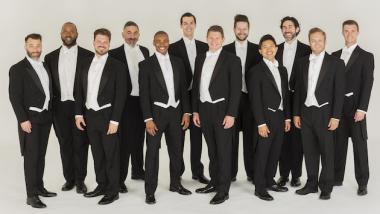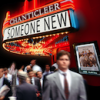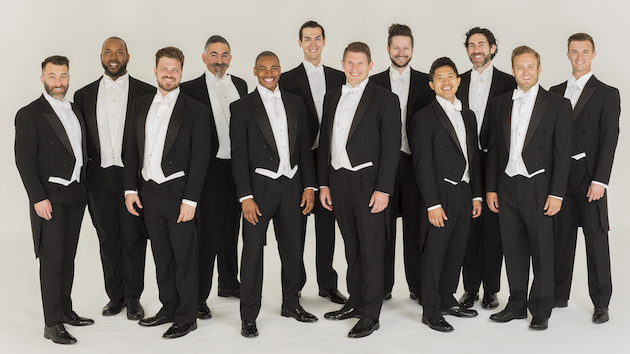
Energy for the all-male a cappella ensemble Chanticleer, as it enters its fifth decade, springs from seemingly incongruous locations. Emerging from centuries-old treasures, buried in medieval, Renaissance, Baroque, and classical music, breezily blowing on fresh air in repertoire by contemporary composers and commissions often infused with jazz, gospel, rock, or pop influences, or tantalizingly floating in YouTube videos, Chanticleer’s 12 members embark on an ambitious, 40th anniversary tour and celebrate the release of a new, 19-track CD spanning seven centuries of music on the Warner Records label, Then and There, Here and Now.
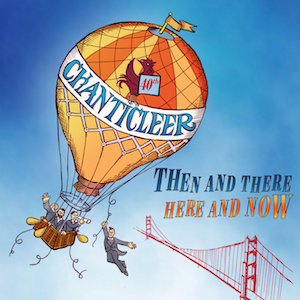 Clearly, there is no standing still, artistically or literally, for the ensemble hailed for wide-ranging repertoire while performing in break-the-mold, flock-like stage configurations. Along the way to becoming “the world’s reigning male chorus” (that, according to the New Yorker), the San Francisco-based group earned two Grammy’s, induction in 2008 into the American Classical Music Hall of Fame, and has established a youth outreach program.
Clearly, there is no standing still, artistically or literally, for the ensemble hailed for wide-ranging repertoire while performing in break-the-mold, flock-like stage configurations. Along the way to becoming “the world’s reigning male chorus” (that, according to the New Yorker), the San Francisco-based group earned two Grammy’s, induction in 2008 into the American Classical Music Hall of Fame, and has established a youth outreach program.
Founder Louis A. Botto’s mission was to establish a high-quality, full-time, salaried, all male vocal ensemble. At the time, in 1978, and in its original ambitions, Chanticleer was a hugely progressive endeavor.
Botto’s rigorous performance and business standards were continued — and arguably, vastly expanded — by Joseph Jennings, who joined the choir as countertenor in 1983 and became music director shortly after that. He retired in 2009. William Fred Scott became Chanticleer’s fifth and current director in 2015.
Scott recalls in an interview his first encounter with Chanticleer, at an Atlanta Symphony Orchestra program including music of the Mexican Baroque. “I had been on the staff of the symphony and was asked if I wanted to conduct this group that almost never used a conductor. I felt, and have every time since, that there’s an incredible charisma. The 12 of them together, they come on the stage like one gigantic, sexy machine.”
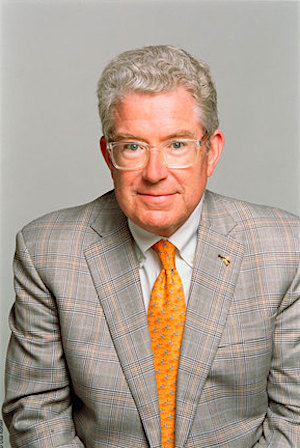
Frequently, Scott says, audiences are completely unaware how hard it is to sing a passage. “They see instead the men picking up cues from each other. In their eyes, their bodies, there’s a hidden communication that has a quality of collegiality.” The energy that travels like electricity through the ensemble during a thorny contrapuntal section sometimes causes Scott to wonder if the audience will lose focus. “Instead, you can hear a pin drop. They watch our men turn deep thought into music in the air.” Working with Chanticleer, he says, “was a love affair from the first second and it’s never ended.”
Prior to coming to Chanticleer, Scott says Renaissance composers were to him “simply names out of a book.” Embarking on his fourth season as music director, he finds hundreds of pieces available in every genre they perform. “The pickings are huge. It would take another 40 years to get to all that’s in our library.”
Add to that hundreds of recommendations of living composers and Scott says a two-hour concert of all-new-to-Chanticleer work is possible, be it Spanish Renaissance music, American spirituals, new arrangements of popular tunes, music written for California Missions, pieces originating in Bolivia and Central America, jazz standards, or any other genre imaginable. “There are still pieces under rocks we’ve not gotten to. And with the new commissions, we’re not trying to reinvent choral music, we’re just constantly looking for people who know how to write things that make us sound good.”
Sounding good means selecting great singers as well. Auditioning for the chorus means preparing songs in a variety of styles and showing proficiency with the dynamics, language and other features of each style. Scott says knowing “how to sell a song, no matter how “pop-y” it is,” is vital. A sign of the times might be that many singers offer supporting talents: proficient in creating videos, organizing airline miles, creating musical arrangements, or understanding various legal and contractual aspects of being a freelance musician.
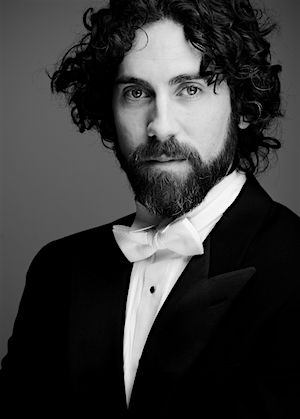
Countertenor Alan Reinhardt is in his 13th season with Chanticleer. He joined during a pivotal year, when more than half the group’s members changed, with seven new singers hired by Jennings. “We were on tenterhooks from the beginning,” Reinhardt recalls. “Joe was a formidable personality. You had to have a thick skin and not take anything personally. The vocal demands were the highest I’ve ever encountered. You came prepared and warmed up to rehearsals. Nothing has changed in that aspect.”
Chanticleer’s ease and camaraderie is evident onstage, he says arise because each singer knows precisely where his voice fits into the grand scheme. “We have to incorporate Fred’s macro vision, honor the composer’s vision, then (absent a conductor) figure out how to do it without them. Deciding where the harmony is headed, which lines require emphasis, or reaching mutual understanding of unique, eclectic, rhythmic passages that absent a slight, subtle alteration lose effectiveness sometimes results in bickering. After all, a small rhythmic change might gain essential clarity or drop the momentum and energy of a phrase. “You never want to hear something sloppy,” says Reinhardt. “We strive for precision and ease. If people are hung up on getting a cut off right, there’s a pervasive uneasiness within the group. If we can minimize that, we can focus on the bigger arc.”
Scott has been listening to vocalists for over 40 years and finds the quality and capabilities of today’s singers have not diminished. What has changed are the means of distribution for music and audience attention spans. “There is so much of what we do that is quickly available. We have live streaming on Facebook, we have national and regional broadcasts. We have a social media committee made up of men of the ensemble because we want to make sure people know about us.” On a CD like the new album, recorded at Skywalker Ranch, Scott says young people today may purchase only one track from their iTunes. Scott says, “The idea of creating any kind of legacy when chances are they’ll only listen to number 12 out of 19 tracks means we have to be sensitive to shorter attention spans, quickness of delivery.”
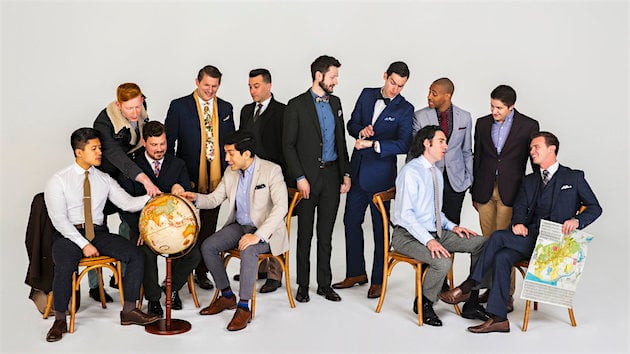
Commissioning new works doesn’t mean ignoring or neglecting the group’s history. While projects with Jennifer Higdon, Zhou Tian, Nico Muhly, Bates and other contemporary composers excite him, there is value in second-hearings of traditional or historic works presented in live concerts. “It’s important to air out those pieces,” says Scott. “Why would you do anything if you thought it would be done one time and put on the shelf? Imagine Beethoven’s Ninth being played one time. Imagine if they’d have said, “That guy’s deaf and we don’t need to do that piece anymore.” Where would we be?”
Similarly, if Chanticleer set aside the spirituals arranged by Jennings and gospel music that have become a signature asset and a favorite of audiences, what would be lost? Scott, a South Georgia Baptist, says, “There is something vulnerable, emotional, and almost desperate about African American spirituals. There’s a quality of soul that in the 21st century we are closer to than to that of a person in Tudor England. There’s a longing to be free that makes it good for us and for audiences.” Chanticleer on tour has found the songs have impact worldwide, regardless of race, ethnicity, religion or even degree of spirituality. Scott suggest there is “something magically obvious but hidden from view in spirituals.” Like all choirs or ensembles, music generated from one body standing next to another music-generating body Scott insists touches a thing a person can’t spot under a microscope but can definitely be heard and experienced.

Reinhardt, proving without aiming to do so that he is of the next generation, declares that Chanticleer’s sustainable future is partially in digital hands. He speaks forthrightly about the ensemble’s social media presence. “That’s a big question for us. We’re approaching a moment in the history of the group where we must take that seriously. There are guys who understand the impact and importance of getting out there on social media platforms. It’s still unanswered from the top, from leadership, what kind of impact those ventures will have on our organization. We’re established as a classical group, so I don’t see the demand diminishing. But we are in danger of losing ground if our presence doesn’t expand.”
He points with admiration to the online activities of other groups, like the British vocal ensemble, Voces 8. “We’ve made a few videos, with multiple shots in nice concert halls, but I don’t know what will drive our expansion. Music videos are important and that’s not something we’ve fully invested in. We’ve focused on concerts and making albums [25 in total], which are wonderful and great, but there could be more content [on the website] for long time fans or for people who’ve never heard of us.”
Which cycles back to the forward-looking energy and the principles and personalities that will define the group over the next decade, if not decades. Seeking harmony and always, Scott’s goal to provide the “invisible, but recognizable, magical power of choral music,” the challenge in coming years is to remain progressive, to continue to reveal hidden treasures and fresh compositional voices, and to engage new audiences, as all music groups must.
Correction: As originally published, this article stated that Chanticleer has had three music directors. Five is he correct number.

